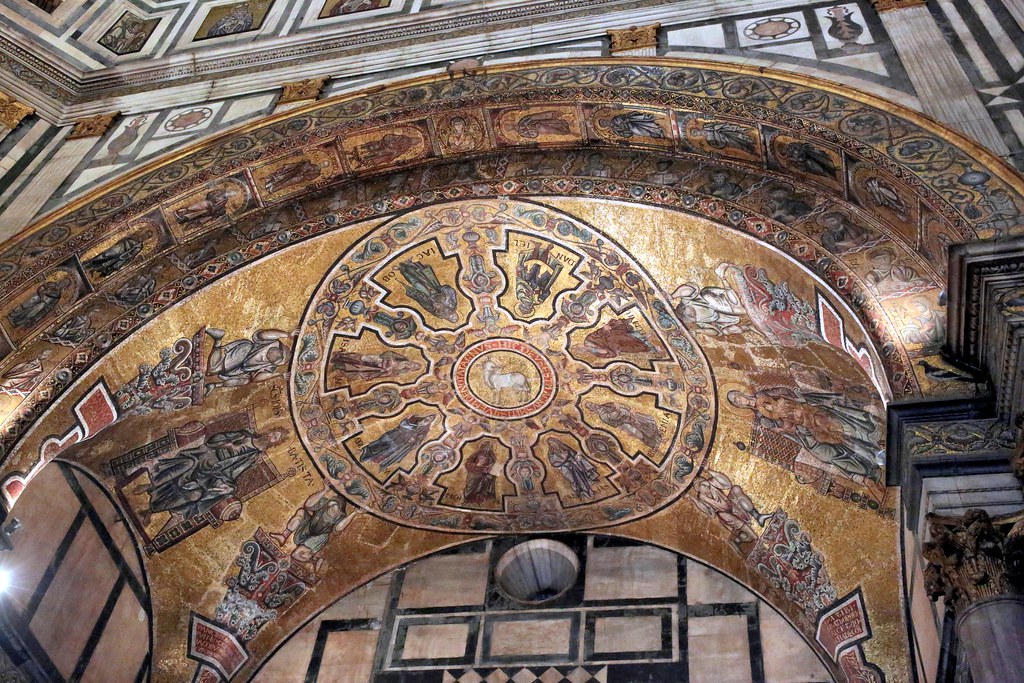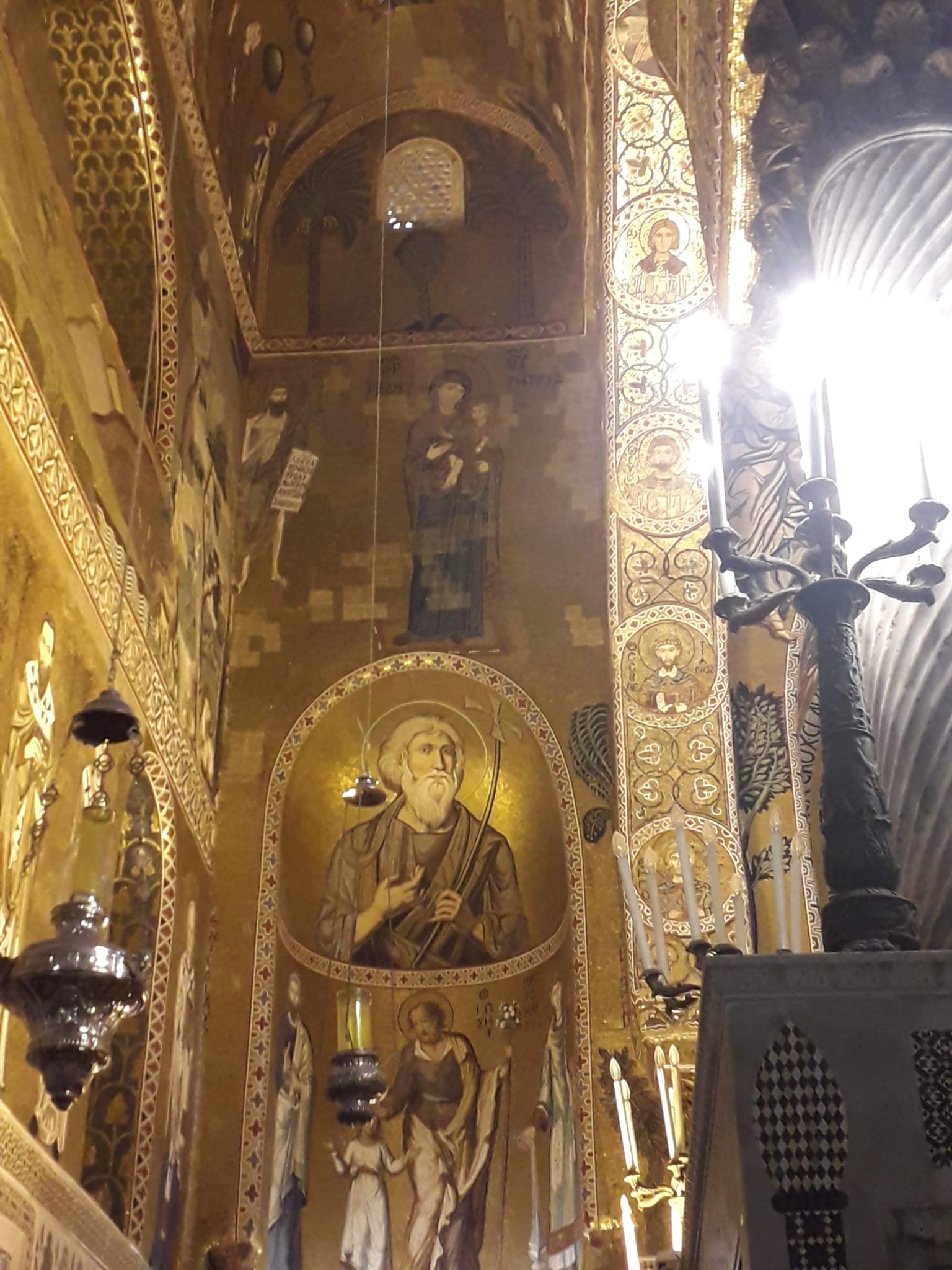
In the early 1200s, the flourishing Roman-barbarian city of Florence was filling its banks and institutions with gold. Close to Rome and bordering on the Exarchate of Ravenna, Florence began garnering its own independence and political organization.
Despite Latin having already fallen out of use by this time, Greco-Roman culture was far from dead. In the Roman territories of the Exarchate of Romagna in Ravenna, Venice and Sicily, Eastern and Western cultures coexisted in perfect harmony.
In the Middle Ages and during the Renaissance, Florence doubled in size, attracting people and massive amounts of gold to the city. This led to the construction of magnificent public and religious works over a short span of time.

Romanesque, built on the marble ruins of Rome
The origins of the baptistry in the center of Florence are shrouded in mystery. It is thought to have been a Roman temple devoted to the god Mars, and Roman marble bas-reliefs are scattered around the striking building, including a sarcophagus.
The uncertain future of the Western Roman Empire
The rise of the so-called mixed Roman barbarian kingdoms throughout Europe found Lombard families organized into secular institutions. It was during this time period that the battle between those supporting either church or empire was fought among Lombard families.
Banks were flourishing and political turmoil among powers led to competition that was militaristic as well as spiritual, cultural, and artistic. From the political struggles of local lords came the Renaissance: the resurgence of a society that would update classical ideals of beauty, wisdom, and virtue and make them the center of their courts.

Roman art revived: Byzantium and the Renaissance
The secular institutions—courthouses, banks, guilds, and palaces—built their city in grey sandstone or erodible brown bricks. Meanwhile, the Comune and its guilds began garnering wealth and influence, and they called the best masters of mosaic.
Along with a group of Florentine painters, Apollonius from Venice and Cimabue covered the Baptistry in gold. Most artists from the 1200s in Florence remained anonymous and worked in schools.
The botteghe functioned as workshops, but occasionally, they were transformed into small makeshift factories. The famous ceramics workshop of the Della Robbia brothers was among these. The Greek tradition of art schools continued through the institution of the bottega, where the likes of Botticelli and Leonardo da Vinci also learned their art. Cimabue is credited with having (re)introduced the art of mosaic to Florence.
The corporations became so powerful they ended up building and sponsoring their own churches alongside the customary financing of churches by individual noble families. New commissioners were hungry for art.

The colors of Classicism
The Florentine Romanesque style includes white and pink marble from Carrara and serpentino green marble from Pistoia as its typical materials.
Officially, the colors symbolized virtues, but they were also representative of the opulence of a city that could afford marbles from quarries in Tuscany, having gained an advantage over Pisa, and mosaic masters from Byzantium.

Only recently, a restoration of San Giovanni (across the square from the baptistry) has revealed more marble statues in a Romanesque style that were meant to be painted in bright colors at the time.
Classical art has always been colorful, and these have kept best on mosaics and frescoes, the two great Roman art styles. Mosaics and frescoes were to the Romans what sculptures were to the Greeks. The art of mixing pigments and art techniques has always been a well-kept secret of respectable art schools from ancient times to the invention of industrial art supplies.

Reviving Roman art: Renaissance mosaics and frescoes
Mosaics would be reintroduced to Italy through Byzantine Italy, but the Roman technique of frescoes had been lost for good.
Roman fresco techniques allowed for more time between the setting of the stucco and the finishing of the painting unlike Italian Renaissance fresco, which was painted by setting the stucco section-by-section and painting over it quickly before the stucco set.
Leonardo da Vinci would try to paint his famous Battle of Anghiari using a reconstruction of what he imagined to be Roman fresco techniques. However, he ended up burning the entire piece of work.
As the Renaissance masters absorbed and relearned Roman art, tastes changed and techniques were applied to other kinds of art. The mosaic art form fell out of favor and intricate stonework came into existence. Out went the golden mosaic that would never fully fall out of fashion in cities such as Palermo, Catania, Rome, and Venice.
Gold leaf layering of Orcagna and the 13th century Florentine masters continued to be a technique that schools passed on.

Artwork was consistently imported from the most remote corners of the Roman Empire until the end of the Renaissance. This was the case throughout the entire time that Florence was culturally active. Florence never forfeited its allegiance to the Austrians, and they themselves were influenced by the models of Greek and Roman classical art they encountered in Florence.
See all the latest news from Greece and the world at Greekreporter.com. Contact our newsroom to report an update or send your story, photos and videos. Follow GR on Google News and subscribe here to our daily email!



